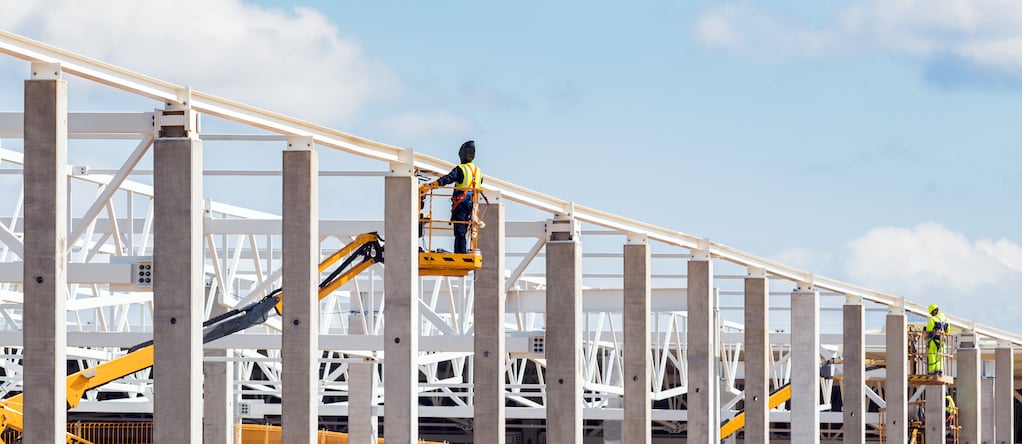The warehouse industry is booming with interest, overshadowing its far less popular sister, office space. As if the divide in demand couldn’t get any worse, in May, the annualized monthly rate for new manufacturing facilities reached record-breaking levels ($194 billion), doubling in the two years since 2021.
Competition for industrial space has been tight as tenants clamor for the best space. Of course, developers have been racing to satisfy the demand with a robust construction pipeline.
But production may finally be catching up. Earlier this year a slight dip in leasing volume put construction at hold until the market absorbs the space. Now, warehouse tenants may find themselves in a sweet spot, the calm before the next leasing storm. Because construction slowdowns are likely to bring a bottleneck of warehouse space availability in 2024. Let's discuss what warehouse tenants need to know to remain on top.
Warehouse Leasing Environment
Back in Q1 of 2023, the leasing volume for warehouse space dropped by 16.3% compared to the previous quarter. Still, this was not something too concerning for landlords because the vacancy rate held steady at 3.8%. And while this is nothing compared to the climbing average national vacancy rate for office space (27% yikes!), it is worth mentioning to understand the full leasing dynamics of industrial space.
Overall vacancies for the industrial space remain low as it continues to be the strongest performing asset in the commercial real estate field.

But compound this slight slowdown in leasing with the fact that hundreds of millions of square feet are about to hit the market by the end of this year. The projected 620.5 million square feet of warehouse space under construction nationwide is set to profoundly impact the commercial real estate landscape.
“The largest pipelines on a percentage of stock basis were found in Phoenix (16.6 percent, 58.8 million square feet), Dallas-Fort Worth (5.9 percent, 52.7 million square feet) and the Inland Empire (5.0 percent, 31.1 million square feet),” according to the Commercial Search.
And this year, 2023, is poised to be a significant turning point, with almost 90% of the ongoing construction projects expected to be completed and available on the market by the end of the year. This influx of new warehouse inventory is providing tenants with an abundance of options to choose from. Because any degree of over-saturation puts tenants in a more favorable position.
But this over-saturation won’t last for long. This is a temporary opportunity for warehouse tenants to pick up on. The market is quickly catching up and absorbing the space because there’s been a slowdown in the construction of warehouse space.
Warehouse Construction Slowdown
Industrial landlords and developers are trying to reign back in their power by shifting the demand balance for properties. So, they are pulling back on new warehouse construction until the industrial market absorbs the space over the next year or so.
|
“Less logistics space will be available in 2024 because of a slump in new construction starts which fell a further 12% in 2Q 2023.” -Prologis |
At the current demand-run rate, the amount of time it would take to absorb all available supply rose by 6.5 months from the first quarter of 2023. Prologis noted that “The uptick was consistent with normalizing operating conditions and rising rents.”
So, since it’s taking longer for new tenants to sign deals as they can afford to be pickier (and drive harder negotiations), there has been a notable slowdown in the pipeline. In the first half of 2023, new industrial construction starts slowed down to 147.1 million square feet, a sharp decline in contrast to the 313.2 million square feet that were started during the same period in 2022.

But this is not the end of the world for warehouse tenants. Construction will likely tick up again but until then, tenants are being advised to strike while the iron is hot. Because along with tighter supply, rent growth is expected to climb further. And as less space hits the market, tenants’ bargaining position becomes weaker.
“Vacancy rates are expected to peak at 4.6% by year-end 2023 are likely to fall to 4% by the end of 2024. This is expected to result in positive rent growth “fueled by rising replacement costs, growing barriers to new supply and ongoing secular drivers to demand,” according to Prologis.
Warehouse Rents
Competition for warehouses post-pandemic has been tight. And the intense demand driven by the rise of
e-commerce facilities, has been reflected in higher rental rates.
|
“Rents have also seen growth in industrial, up to 27% over 12 months.” -GlobeST |
So even though hundreds of millions of square feet have been actively hitting the market, warehouse rents have been showing consistent returns. After the second quarter of this year, rents rose 2%, but Prologis forecasts that a rise of 7% to 9% is on the horizon for the rest of the year.

“After years of double-digit rent growth led to more than 100% rent growth in some markets, leases will experience “substantial repricing” when they expire," according to Prologis.
Besides the vacancy rate, the other metric that denotes the health of the current leasing environment is the occupancy rate which tracks how much of a leased building is used or occupied. In terms of warehouse space, average utilization is performing extremely well.
|
“Utilization on average remained in the sweet spot of 85% to 86% during the second quarter.” -Prologis |
So not only is industrial extremely healthy, but no part of it is going to waste! The utilization metric highlights the industry's strength and its ability to meet the evolving needs of businesses and consumers efficiently. Not only this, but it points to further success on the horizon.
Part of the booming warehouse success is due to the sustained demand for U.S. based facilities that ease the flow of goods through the country. And the two legs of this are the tailwinds from online manufacturing and an increasing presence of onshoring in business operations.
What Warehouse Tenants Need to Know
As the market continues to experience the entry of a significant number of new warehouses in the latter half of 2023, tenants should seize this opportunity to secure favorable deals and optimize their logistics operations. Because 2024 may have an entirely new leasing environment in store for tenants since new construction is slowing significantly. Currently developers aren't motivated to invest in speculative developments with interest rates at this level and this will put a heavy ding in the supply of warehouse space.
|
“Customers are advised to take advantage because the rapid decline of new construction starts and delayed decision-making could increase competition for space in 2024.” -Prologis |
While rising rents may appear challenging, by capitalizing on the current increased supply and competition, tenants can negotiate advantageous lease agreements, reducing their occupancy costs and positioning themselves for success in the evolving commercial real estate landscape. In leveraging their position, tenants can potentially secure rent rates, lease terms, and concessions that align with their needs and budget and get the right warehouse location for your business.
To stay on top of the evolving demand for warehouse space, corporate tenants need to become aware of the factors that influence their position. Watch our free video course to get insight on what to do when touring your next warehouse space!








